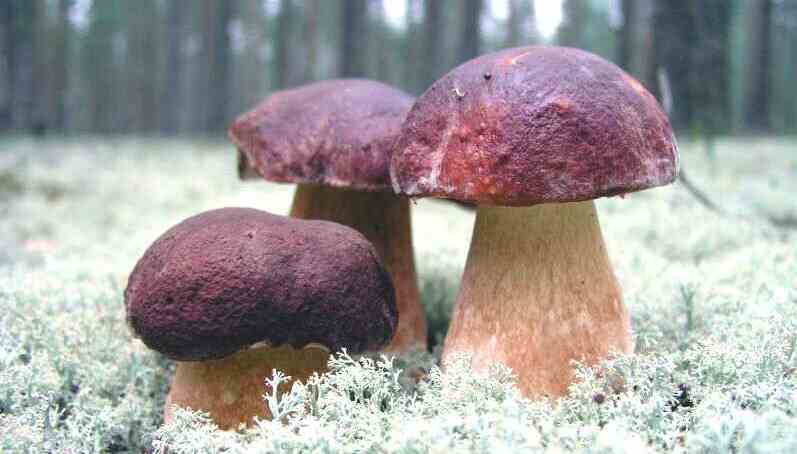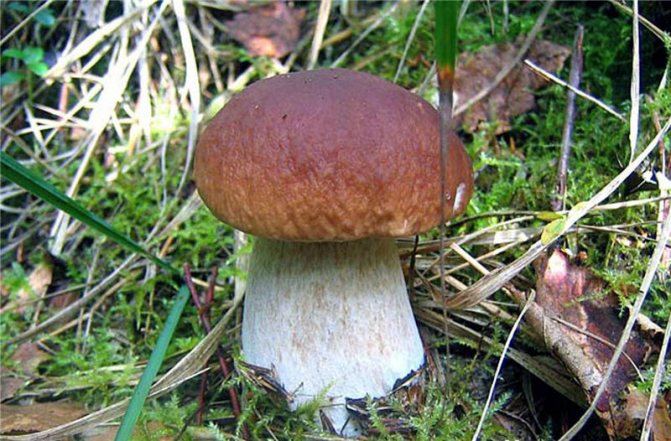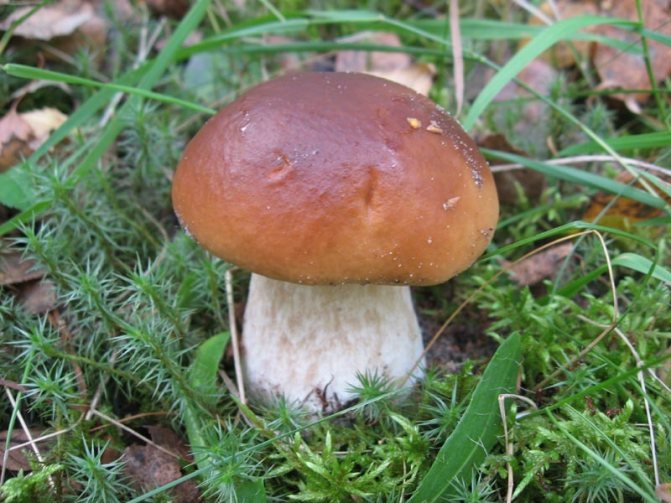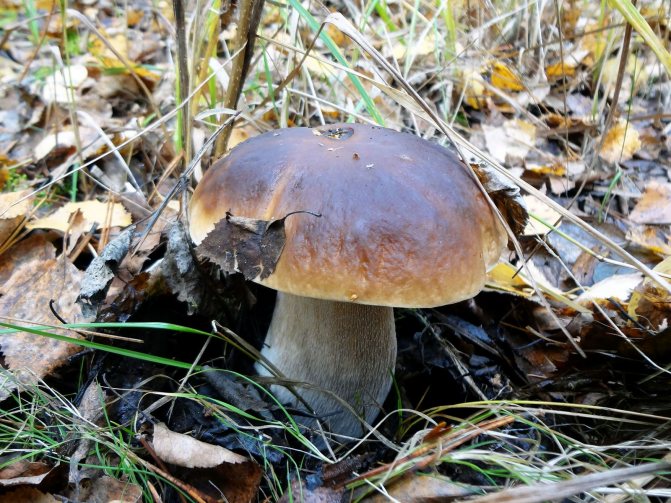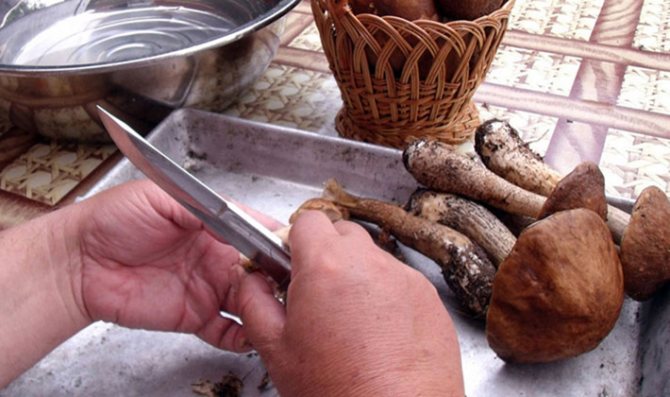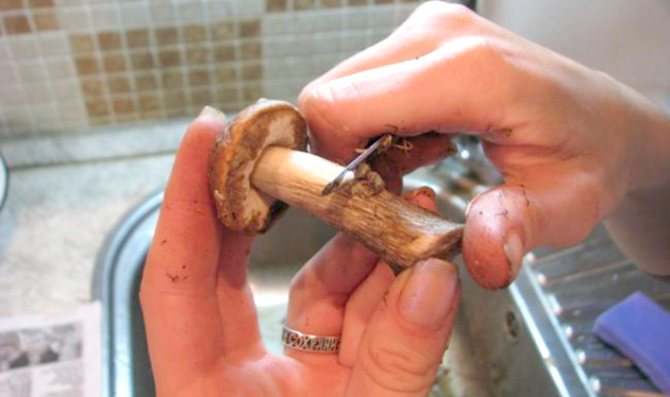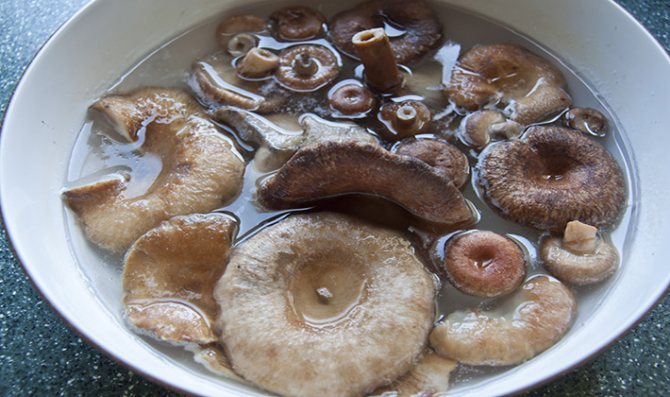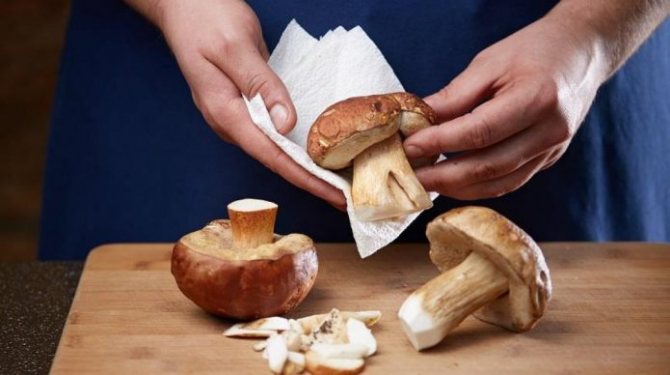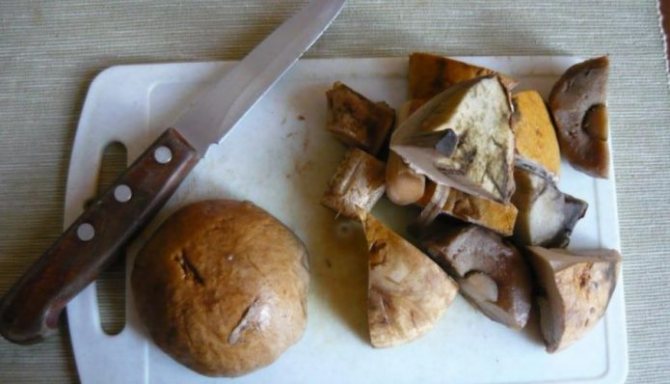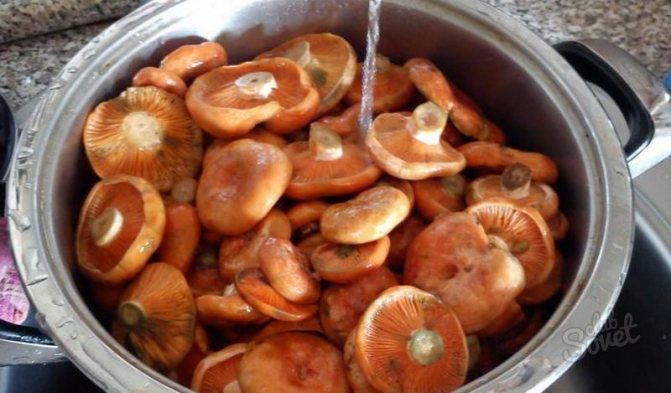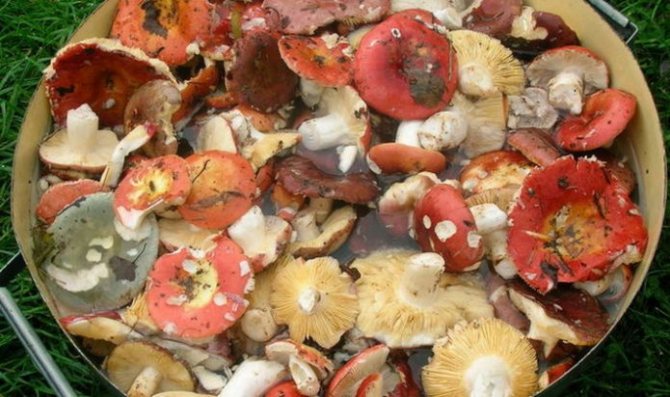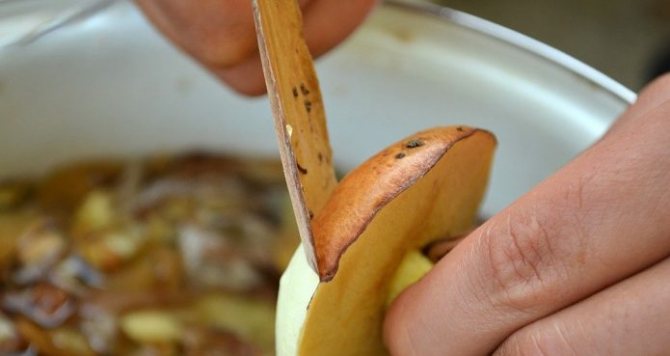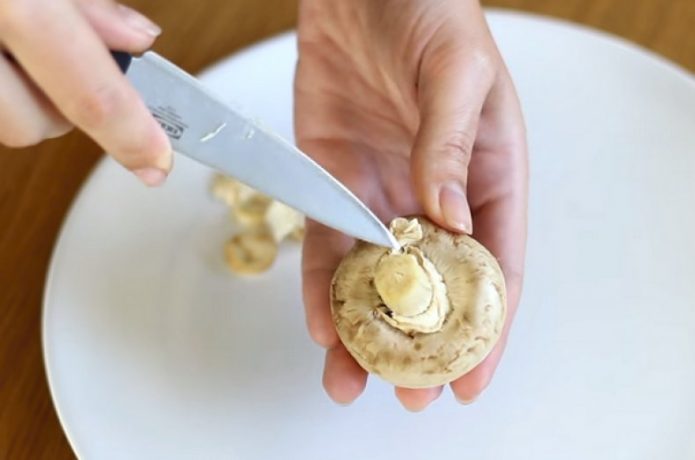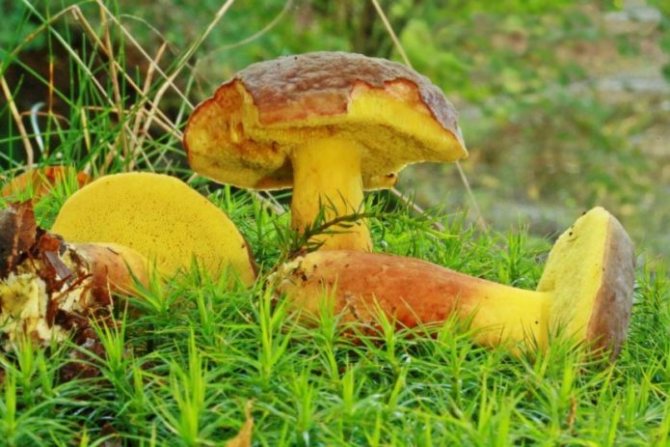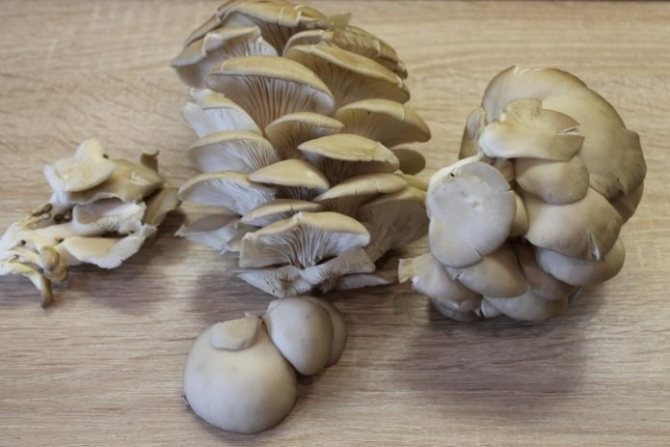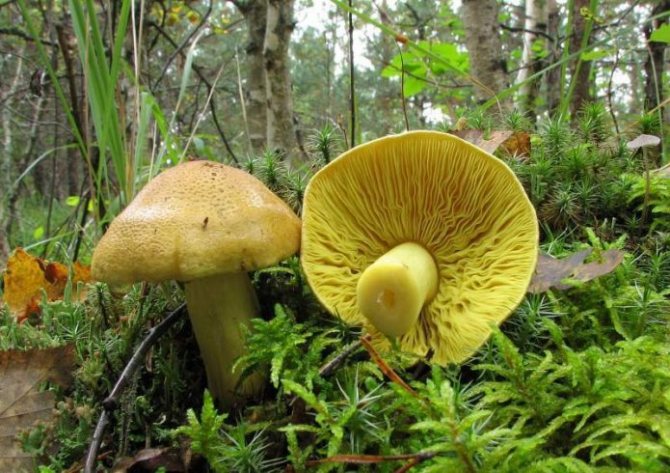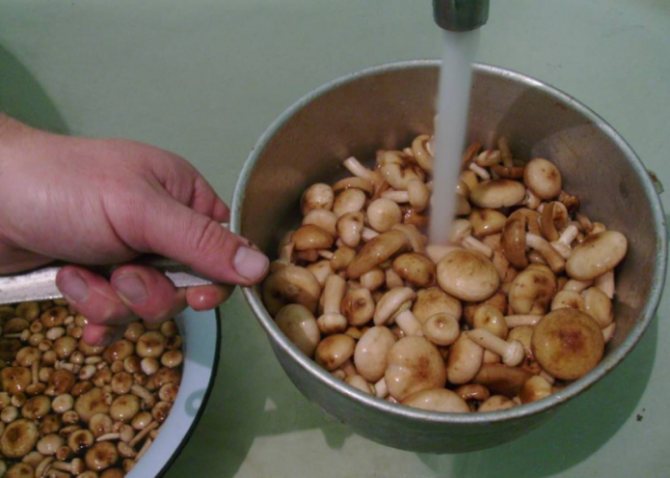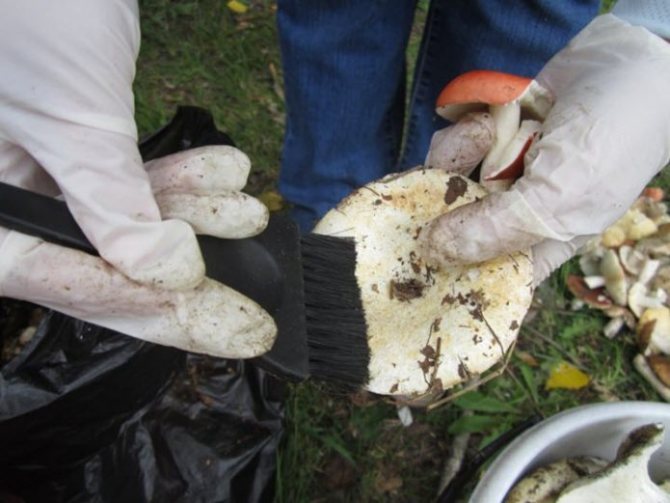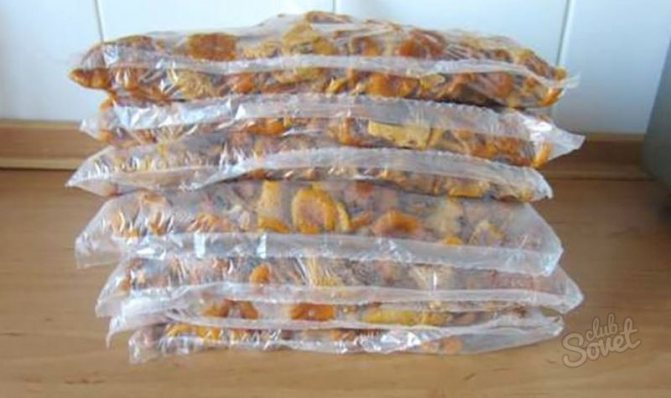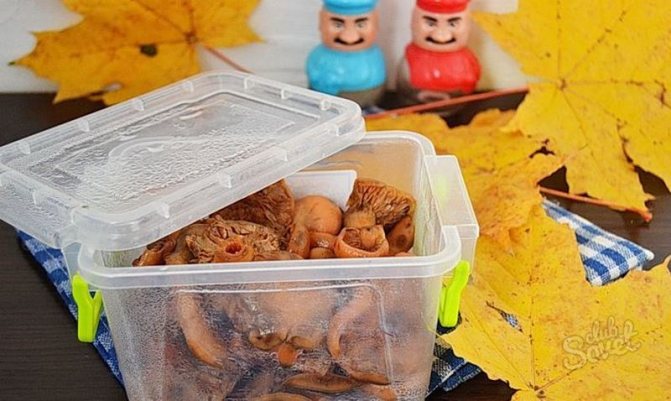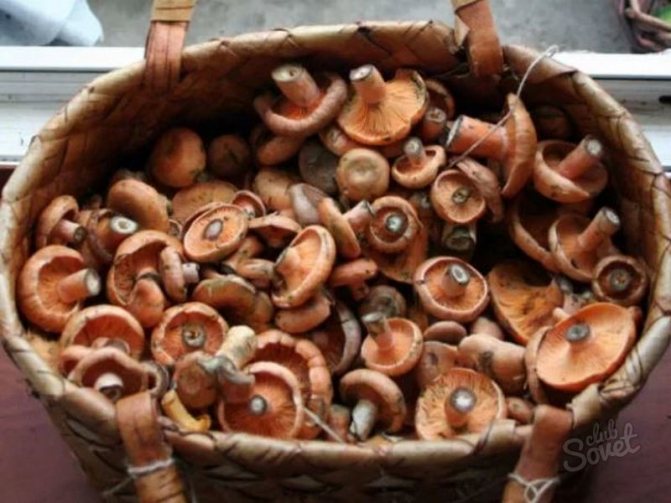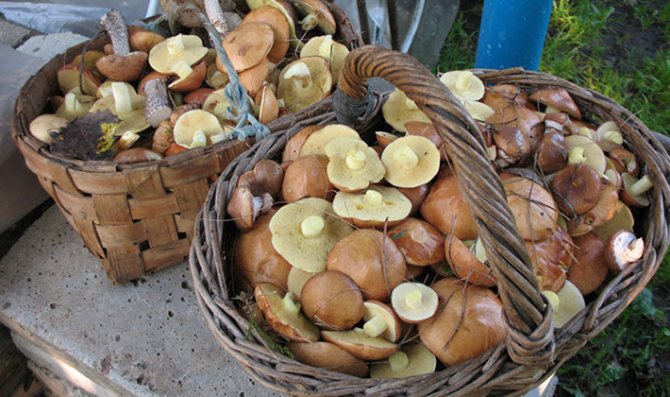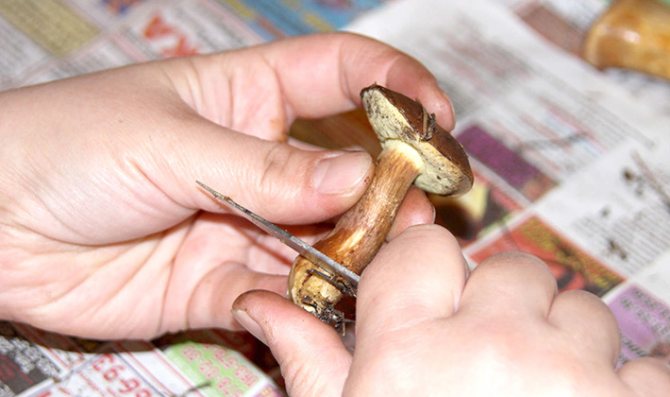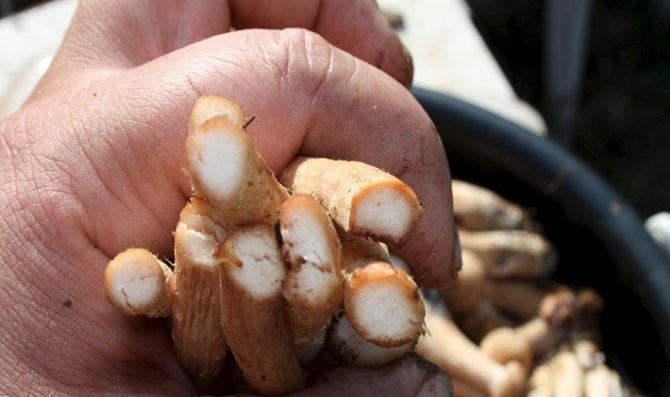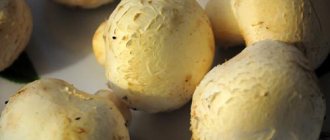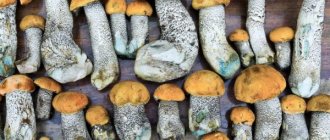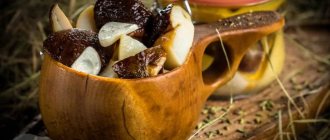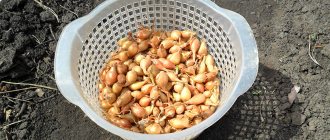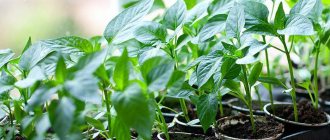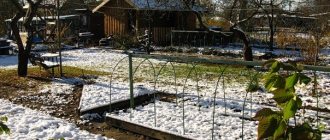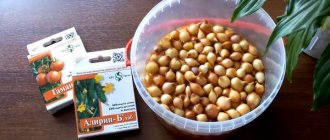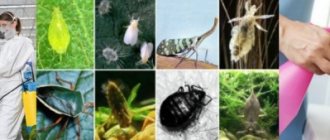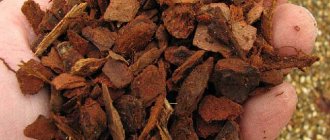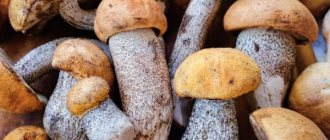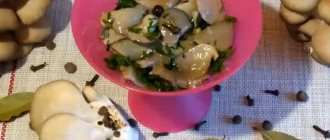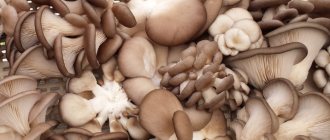Features of the view
The porcini mushroom belongs to the first category in terms of taste, with a valuable nutritional composition, noble white and dense pulp, which does not darken on the cut and during heat treatment.
The hat is brown, of light and dark shades depending on age, velvety to the touch, 7-30 cm in diameter, and in a particularly favorable climate it can even be found up to half a meter. The form at a young age is hemispherical, straightens over time.
The leg is up to 12 cm, in some giants - up to 25 cm. The thickness is 7-10 cm. The shape is cylindrical, sometimes similar to a barrel or mace. The color is both white and brown, sometimes a fine mesh of the pattern is visible.
The mushroom is found on almost all continents, it loves humidity and warmth, therefore, depending on the weather, it can appear in May and autumn.
Grows in any forests: coniferous, deciduous and mixed. It belongs to symbionts, forms mycorrhiza with oak, pine, spruce, fir, birch, hornbeam, aspen. It is not capricious to soils, it can grow on sand, and among mosses and lichens. Therefore, on the collected whites, you can find needles, fragments of dry leaves, sand, moss, depending on the place of discovery.
General rules for cleaning porcini mushrooms
Regardless of the further use of porcini mushrooms, many actions after cutting them in the forest are the same for everyone. Therefore, there are general rules:
- The first thing to remember: cleaning all the mushrooms is an urgent matter, this is the first thing to do after returning from the "quiet hunt". Boletus has a rather dense pulp, but the decomposition process is natural for all species. Therefore, the mushroom picker ideally has 3-4, maximum 5 hours to cope without loss.
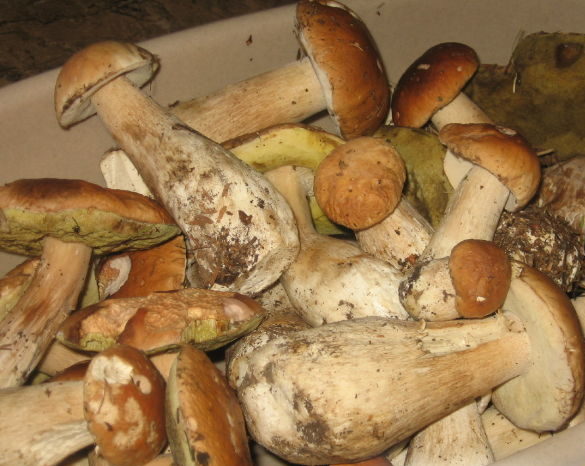
Harvested mushrooms
- Much more convenient and effective mushrooms will be cleaned if you use not only a knife, but also have auxiliary means: an old toothbrush, a rag.
- The beginning of cleaning is the removal of large debris: leaves, needles, etc. If there is time, then this is done even right in the forest, before placing the crop in a basket. At home, you can connect a brush or cloth to sweep away as many debris as possible.
- The washing up.
Preparation
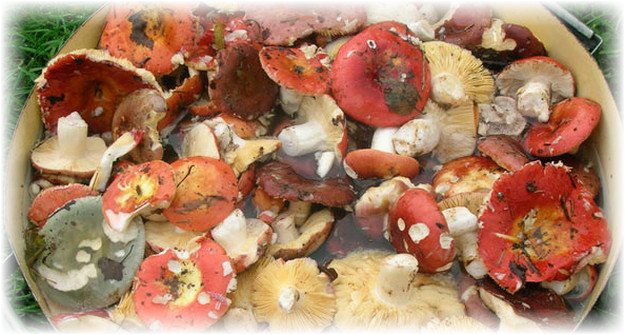

Mushrooms must be sorted, taking into account:
- How dirty they are.
- What sort are they.
- We'll have to dry or cook them.
- Are there wormy places.
- Product dimensions.
The cleaning begins no later than six hours after the trophies of the quiet hunt are brought from the forest. If there is no way to immediately start cleaning, then the raw materials must be placed in the refrigerator so as not to deteriorate.
Tip: special attention should be paid to wormy places. It is better to cut them out immediately at the place where the mushrooms gather. Worms easily crawl from one mushroom to another, spoiling the harvested crop. It is believed that mushrooms grown on special mushroom farms cannot contain worm-like lesions. However, this is a delusion. Such products should also be carefully inspected for tainted parts. To surely free them from intruders, you need to put them in salted water for a short time. The worms themselves will leave the pulp, which is not tasty for them in this case.
The subtleties of cleaning before frying and cooking
Boletus is extremely tasty when fried, as well as in famous soups, where it looks like white meat without losing its color during cooking.
The mushroom bodies selected for these purposes at home are cleaned with a knife blade from surface debris, adhered needles, blades of grass are removed, and the ground is scraped off the leg. Then they can be washed. If the mushrooms were collected on sandy areas, or, for example, in the rain, then they may be more contaminated than usual, and then it is recommended to soak them in water for a quarter of an hour, pressing with something from above, so that the stay in the water is effective - such soaking will separate sand and earth particles.
After rinsing in running water, fold the boletus into a colander and drain off excess liquid. Then we work with a knife: you need to eliminate everything that easily lags behind from the fruit, scrape the leg, refresh the lower cut and check for worminess, remove all dark spots of pulp.
Before frying, the prepared mushrooms can be poured over with boiling water, this will be that control rinse, removing the final debris and killing microbes. Then let the water drain and air dry. That's it, the harvest is ready to use in your favorite roasting recipe.
For cooking, you can also manipulate boiling water. Since the porcini mushroom is a high quality product (of course, if it is not collected in radioactive and chemically contaminated places), therefore, it is not necessary to additionally boil it before the main cooking, as is the case with mushrooms of lower categories.
Gardeners reviews
I do this: I soak the milk mushrooms for a day, then I scrape with a knife under the tap, I also try to scrape out the points, if the damage to the mushroom is large, you can cut it off a little. Ideally, the milk should be white.
xxx
I soak the mushrooms in the sink for about an hour or two, and scrape them with a knife. They turn out white and clean. True, my hand is full - since childhood I have been doing this at least once a year. But as a more convenient alternative to a knife, you can take a metal sponge or just a dishwashing brush. It will be much faster this way.
Salvanelli
As for the butter: I remove the skin for purely aesthetic reasons. But sometimes the peel not removed gives a slightly bitter resinous taste in pickled butter. As for the sand in greenhouses: I did the same with them as I do with russula. If there are a lot of mushrooms, I do not clean it at all, not wash it with a sponge. I dump everything into a basin and fill it with water at the stage of "white" boiling so that there is a thick mixture, the water only covers the mushrooms. After 5-7 minutes, the mushrooms will soften. Take a slotted spoon, start stirring vigorously in different directions, like in a washing machine. Mushrooms rub against each other.
Ariona
I cut off the leg of honey agarics with a thin leg even in the forest (more precisely, I cut off mushrooms without it), and leave the thick ones. In my opinion, there is very little garbage when collecting honey agarics. I go through them at home just to admire once again and see if all the mushrooms are good.
Sugar
Actually, in this way I clean all the mushrooms that do not need to be dried in the future. I'll make a reservation right away, we don't take russula. Therefore, I can't even imagine if it is possible to clean them like that. The mushrooms are cleaned of large debris, the leg is slightly trimmed. Do not cut the mushrooms! Then I throw it into boiling water for a minute, put it in a colander and start rinsing it: the mushroom becomes elastic, flexible, sand and dirt are easily washed out from everywhere. If honey mushrooms were removed from the tree by families, then I slightly cut the legs, dividing the mushrooms. Then I put the mushrooms in a large basin with a layer of 15–20 cm, pour out a pack of salt, pour a couple of glasses of water, maybe a little more. And carefully I begin to stir the mushrooms, literally for a minute. Then I pour a large amount of water into the basin. Honey mushrooms come up, all the dirt is below. I collect mushrooms with a colander, rinse right in it with running water. My pelvis is large, oval. There must be a bucket of mushrooms at a time, maybe more. For washing honey agarics I use coarse rock salt.
Kalina
In champignons, I cut off the edge of the leg, if there are very dark spots on the cap, then I clean them. And if the skin on the edge of the cap is hanging very strongly, then I can pull it off.
Princess in uggs
Mushroom picking is not as time consuming as cleaning it. Each type has its own nuances that must be taken into account. Otherwise, ready-made meals and homemade preparations will not be as tasty as we would like.
Preparation for freezing and drying
The general rules in the case of drying and freezing are changed by one point: contact with water is excluded here. That is, neither quick rinsing nor, moreover, soaking is carried out. For high-quality removal of dirt, instead of water, use a cloth, slightly moistening it for better adhesion of debris, or a brush from a hardware store or even an old toothbrush.
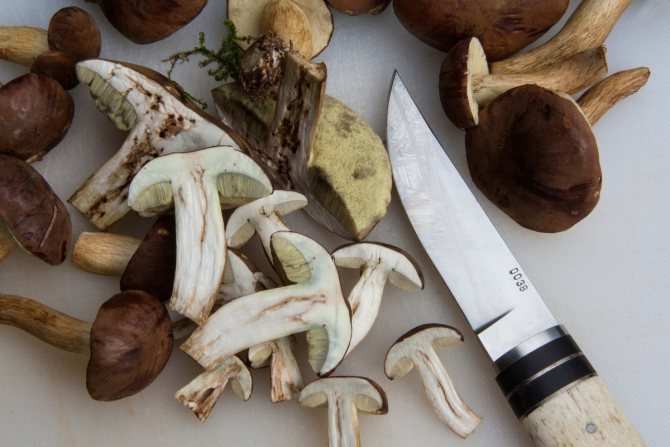

You can finally go over the surface again with a cloth (new, not the one used at the beginning of the cleaning process) and start slicing before drying or freezing.
Cleaning porcini mushrooms before pickling and pickling
Usually, small strong mushrooms are chosen for conservation. The selected boletus are swept with a brush from large forest debris and earth, and then washed for 10-20 minutes, constantly changing the water, or even soaked in salted water with the addition of citric acid or vinegar. This action has two purposes:
- so that the mushrooms crunch from a properly prepared recipe, and not from sand - water removes sand from all crevices of the fruiting body;
- frequent washing and soaking in salt and acid kills possible bacteria, which are especially dangerous during cold salting, when the mushrooms are not boiled before conservation at all.
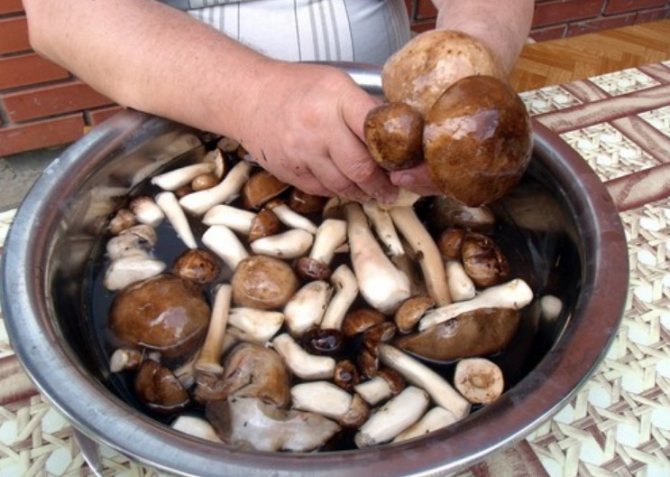

Soaking mushrooms
After thorough washing, the final step will be to cut off all suspicious fragments, darkening, damage, stripping the leg, removing the pulp where it easily lags behind. As a result, we get a white fruiting body, ready for pickling or pickling.
How to clean a porcini mushroom cap
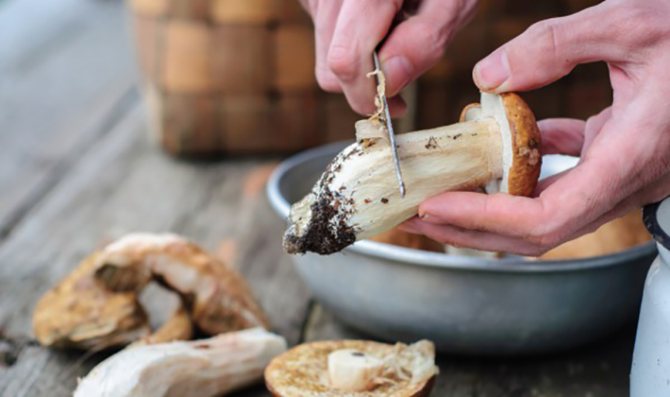

Fresh mushrooms are stored for a short time, therefore, within 3-4 hours after harvesting, they must be processed - sorted and prepared for canning or used for preparing mushroom dishes. If you can't process the mushrooms right away, transfer them to an enamel bowl without a lid and store in the refrigerator for 1-2 days. At the same time, they should be shaken as little as possible and shifted and taken in hand carefully so as not to leave dark spots and dents. Preparing mushrooms for culinary processing consists in clearing debris (adhered blades of grass and insects), removing darkened or damaged areas.
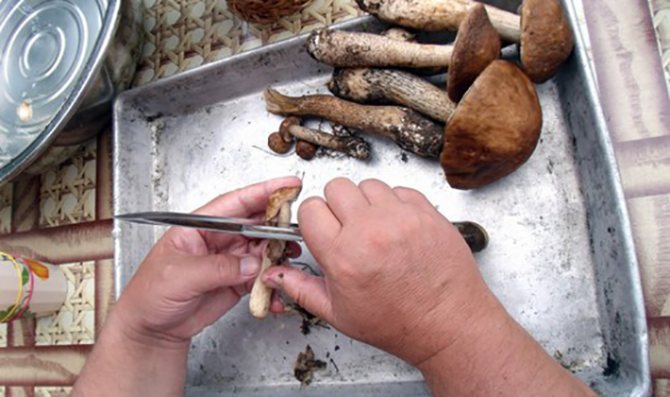

Before cleaning the cap of the porcini mushroom, clean it with a knife with a stainless steel blade or a soft cloth. The cut on the legs is renewed, removing the most contaminated part. If mushrooms from the forest are heavily contaminated, they are soaked in water and pressed down with a load for complete immersion. After 10–20 minutes, the caps are easily washed from the adhering grass and leaves. You should not leave the mushrooms in the water for a long time, as they will actively absorb it, which ultimately will negatively affect their taste and aroma, and make the caps brittle. Then the mushrooms are washed with clean running water. Particular attention is paid to washing the lower surface of the mushroom caps, which is spongy or lamellar, and therefore most susceptible to contamination. Then the mushrooms are left in a colander or sieve to drain the liquid. The exception is mushrooms intended for drying and, sometimes, freezing. They are only cleaned, but not washed with water, much less soaked.
See how to peel a porcini mushroom in the photo, which shows the whole process step by step.
How to wash mushrooms
Most experienced housewives agree that before cooking mushrooms, they must be washed. Regardless of what is planned to be done with the raw materials in the future (stew, fry or boil), the harvest harvested in the forest must be freed from accumulated dirt and microbes. However, any culinary specialist knows about the ability of these mushrooms to absorb moisture. Therefore, it is important to adhere to the golden mean in the process of cleaning saffron milk caps: contact of the product with water should not be prolonged.
You can apply a special washing algorithm for fruit bodies:
- Cleaning saffron milk caps from adhering leaves with a sponge.
- Cutting off damaged areas and removing dirt from the leg.
- Washing fruit bodies under cold running water. It is better to take each mushroom separately for this. This makes it easier to make sure of the effectiveness of washing and to protect raw materials from unnecessary contact with moisture.
How to peel a porcini mushroom
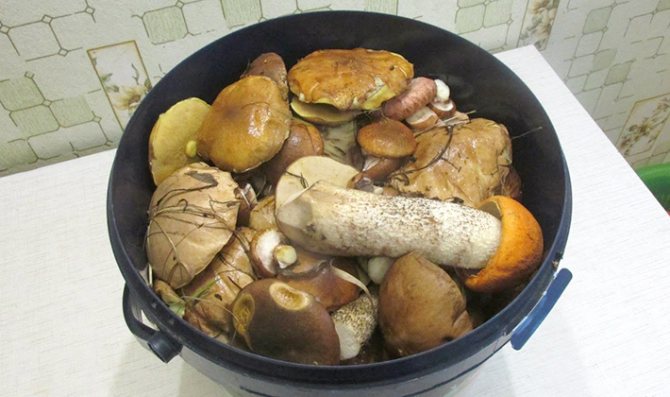

You can read about how to peel a porcini mushroom for a particular culinary processing further on this page. Mushrooms are dried in their natural form, and for freezing they are pre-cut into thin slices or pieces, depending on the size. The first and foremost requirement when processing mushrooms is a careful inspection, as they can be heavily soiled and clogged with sand. Mushrooms should be processed only young, completely healthy, not wormy, with trimmed roots, without any debris, needles, leaves, soil, and only freshly harvested.
Sorting and cleaning is an important step. For marinating in a hermetically sealed container, take only a boletus cap.
Porcini mushrooms intended for canning in a hermetically sealed container are also sorted by color or by the place of growth: spruce, pine, oak, birch boletus. In accordance with the distribution by varieties, the leg is also cut off. The peel from the remaining stump at the cap is scraped off with a knife. In addition, mushrooms are thoroughly cleaned of adhering debris, needles, twigs, particles of earth, and all wormy specimens are discarded. Less wormy ones are cut into wormholes. Mushrooms intended for drying are finally cleaned with a wet cloth, and the rest are washed.
How to peel porcini mushrooms before freezing
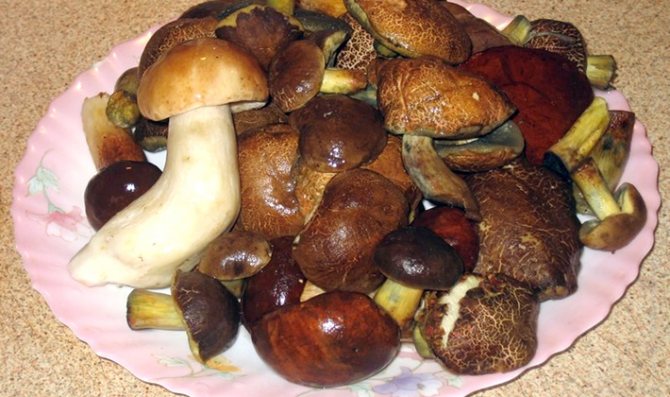

Washing is the most important preparatory process. The quality of finished products depends on its thoroughness. Therefore, special attention should be paid to washing, taking into account at the same time that during prolonged washing, there is a loss of aromatic and soluble dry substances. Therefore, the washing time must be limited.
You can wash the mushrooms well without loss within 10 minutes, while changing the water several times. It is best to wash the mushrooms in running and continuously changing water, especially with a pressure jet. Before peeling the porcini mushrooms before freezing, please note that if the boletus is overly saturated with water, this indicates that they are overgrown or damaged. During the decay process, harmful substances can be formed, such as the poison neurin, as a result of which edible mushrooms can become poisonous. It is impossible to pull the mushrooms out of the ground, since the structure of the mycelium is disturbed, after which the filaments of the mushroom mycelium die off and do not bear fruit. The mushrooms must be carefully cut with a knife.
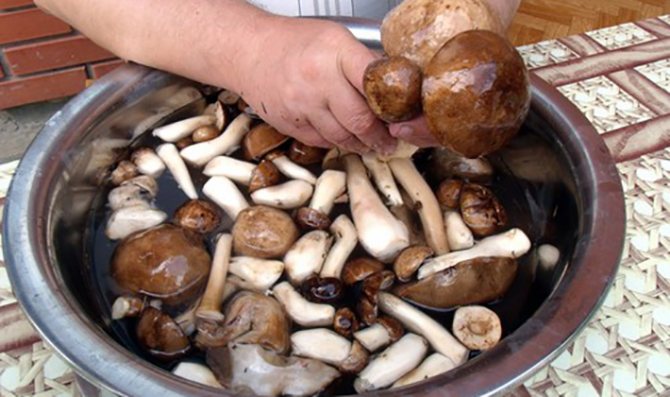

After cutting off the mushroom, check if it is wormy. In addition, by cutting off mushrooms with a knife, we reduce the possibility of contamination with adhering soil. The collected mushrooms are immediately cleaned of adhering to them earth, leaves, needles, grass and other debris; remove parts affected by insect larvae. Heavily soiled lower parts of the legs are cut off. Put the mushrooms in the basket with the caps down - this way they are better preserved.
Mushrooms contain more than just soil particles.
They can also contain insect larvae. To remove them, it is necessary to soak the mushrooms for 2 minutes in a 1% salt solution - 10 g of salt per 1 liter of water.Soaking will also help partially remove soil, pine needles, manure and peat particles that may contain parasites and microbes. And only after soaking, the mushrooms are placed in a colander and washed under running cold water for several minutes.
See how to peel porcini mushrooms before cooking in the photo showing the subtleties of this process.
Drying is one of the simplest methods of processing mushrooms. Porcini mushrooms (boletus) are most suitable for drying. Mushrooms are carefully examined, cleaned with a knife from moss, leaves, needles and other forest debris. They discard the accidentally collected inedible and wormy ones, cut out the damaged parts, separate the caps from the legs, if the skin is easily separated from the pulp, it is removed. Wipe the mushrooms with a dry or damp cloth. Do not wash. After that, thick legs are cut across into circles up to 3 centimeters thick, and thin ones along, into two or four parts.
Tips & Tricks
The texture of the legs and caps of porcini mushrooms is noticeably different - the legs are usually denser and stiffer. Therefore, when cleaning, the leg and cap parts are often separated, and then they are prepared separately.
If porcini mushrooms are harvested shortly after rain and are heavily soiled, soak them briefly in salted cold water and then rinse them. The same is done if there are still several wormholes left in the pulp. Soaked and then washed mushrooms can be used without hesitation for boiling and pickling, they are less suitable for frying, and they definitely should not be frozen and dried.
It is not without reason that porcini mushrooms are considered especially valuable mushroom raw materials - in their multicomponent composition, in addition to aromatic and nutritious ingredients, there are substances with antitumor and tonic properties. The preservation of unique biological complexes largely depends on the careful, correct and timely cleaning of porcini mushrooms before cooking.
Porcini mushrooms are loved by many for their exquisite taste. But in order to fully enjoy them, you need to know what to do with porcini mushrooms after picking, how to properly process them. This is what "Popularly about health" will tell its readers who are very fond of boletus.
Primary processing of porcini mushrooms
Collecting porcini mushrooms is a whole art. If you still do not have much experience in this matter, then you should know that the processing of boletus begins immediately after collection, right in the forest. What should you do with mushrooms?
1. After harvesting, porcini mushrooms must be cleaned of debris - grass, leaves, coniferous needles, fragments of branches.
2. Next, you should inspect the product for damage - places corroded by insects should be removed with a knife and discarded.
3. Inspect the mushrooms for parasites - cut off the wormholes. Never put wormy specimens in a basket with intact mushrooms.
4. When placing boletus in the basket, do not press down on them, handle them with care.
Back home, you have to immediately set aside time to process the product. Remember that all mushrooms spoil very quickly, so don't put off this work until later.
What to do after harvesting, how to process porcini mushrooms at home
?
Carefully put the collected forest gifts in a basin and revise again, removing the remains of litter. Then place the porcini mushrooms in cold water. This is necessary so that all the dirt on them is soaked and easier to remove. The mushrooms are very light and porous, they will float unruly to the surface, so place a load on top. After 15 minutes you can start cleaning them. To do this, you will need a knife and a scraper or stiff-bristled brush.
Use your hands to remove all the dirt adhering to the legs and hats. After that, the water should be changed to clean water. Now arm yourself with a scraper and use it to remove stubborn dirt.Then turn each mushroom over and use your fingers to massage the grains of sand and dust from under the caps. A lot of small debris collects in the so-called gills. Rinse the mushrooms in running water, removing suspicious dark fragments with a knife.
Throw the boletus into a colander, let the water drain. Now porcini mushrooms should be processed after harvesting at temperature.
Attention! If you want to dry the collected forest products, then they do not need to be soaked and washed. It is enough to manually remove the dirt and cut off the damaged tissue of the mushrooms.
How to properly dry porcini mushrooms
?
Drying boletus should be carried out at a temperature not exceeding 50 degrees. It is very easy to do this in the oven. Place baking paper on a baking sheet, put boletus in one layer. Turn on the oven at 45-50 degrees, insert the stopper into the door so that it does not close. Dry the product for at least 6-7 hours. If you have a special drying chamber at your disposal, follow the instructions.
How to cook porcini mushrooms
?
Heat treatment of boletus is necessary to exclude the possibility of poisoning with toxins. We send the product into salted water (a teaspoon of salt per liter), bring to a boil. Be sure to remove the foam formed on the surface. After boiling, we detect 40 minutes. We put the finished mushrooms in a colander.
How to freeze boletus
?
For long-term storage of porcini mushrooms, freezing is often used. It is best to freeze the product already boiled. After the water is completely drained, and the boletus is slightly dry and cool, place them in clean bags. Pack so that there is one portion of the product in one bag that you can use at a time - it's more convenient. Release the air from the packages, tie the bags tightly, and then place the packages in a super-freeze chamber for 2-3 hours. If you have other types of mushrooms in the freezer, it is better to sign the packages so that you do not confuse them later. After 2-3 hours, transfer the bags to the regular compartment of the freezer.
How porcini mushrooms are cooked
?
Boletus mushrooms are versatile, they make delicious snacks - pates, caviar, salted, pickled, fried, baked, soups. For pickling, either small mushrooms are chosen, or only caps are used, cut into several fragments. It is very important that the boletus is not the slightest sign of spoilage. Boletus legs are most often used to prepare mushroom caviar - this is a truly royal delicacy, and they are also fried. The frying time of porcini mushrooms, which have been pre-boiled, is 15 minutes.
And of course, these mushrooms are good when salted. From time immemorial, housewives have salted them in barrels in large quantities, this tradition has survived to this day. Hardly anyone can refuse such an appetizing snack. For soup, it is better to take a dried product, as it has a richer aroma and taste. Dried boletus is first soaked, washed thoroughly, and then boiled.
Porcini mushrooms are a luxury for many, but if you have already managed to collect them in the forest, then it is important to know exactly what to do with them, how to process and prepare them for storage. Remember that the product deteriorates quickly, so do not postpone cleaning, washing and further processing of mushrooms until later.
How to peel porcini mushrooms for freezing
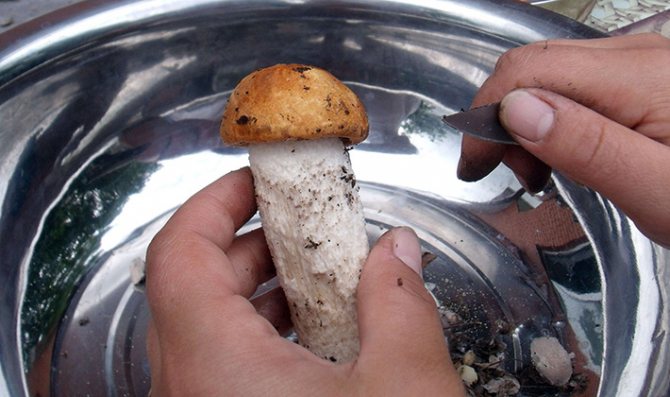

Many people simply wash mushrooms before freezing them under running water. But this is not enough. After pre-washing, immerse them for 2 minutes in a 1% salt solution, then drain through a colander and rinse again. So bugs, worms and parasite larvae, which may not be noticed, will be detached from the fungi. Before peeling the porcini mushrooms for freezing, they can be slightly chilled in the upper compartment of the refrigerator.
Then we cut off all unnecessary mushrooms. We cut large mushrooms into pieces, and leave small ones whole. Then put the mushrooms in a colander and leave for several hours. The mushrooms must dry.We put mushrooms in bags or containers. Freeze and store at temperatures from –18 to –23 ° C.
General recommendations for cleaning mushrooms


After the mushrooms are sorted out and decomposed by type, we proceed to cleanse them. To do this, we use hard brushes, a dish sponge, a thick cloth towel and a small mushroom knife. We remove dirt, darkened parts and areas eaten by worms (if the mushroom cap is affected by them, we throw it away). Next, we wipe them with a damp cloth or quickly rinse them through a colander and dry them.
On a note!
Mushrooms to be dried are not washed.
Porcini mushrooms (boletus)
The boletus can be up to 25 centimeters in height. On average, the height of a standard mushroom is 12 centimeters. The cap of the porcini mushroom has an average diameter of 30 centimeters, but there are cases when boletus with a cap, the diameter of which reached 50 centimeters, has been known. The dryness or dampness of the cap is due to the growing environment. For example, in dry areas of the forest, porcini mushrooms grow with a dry cap. Accordingly, in the shady side of the forest, where there is high humidity, the caps of the mushroom are slightly damp to the touch.
Useful properties of porcini mushroom.
However, housewives love porcini mushrooms for their ease of cleaning, beneficial properties and for their fleshy cap. Despite the fleshy cap, the porcini mushroom is considered a low-calorie product, as a result of which it is classified as a dietary type of food.
An interesting fact, but dried mushroom is considered very high in calories and frequent use of boletus can lead to obesity.
Porcini mushrooms contain a group of vitamins A, D, C and B1. However, if mushrooms were collected along busy highways and in industrial areas, then it is better not to eat such mushrooms. The porcini mushroom is a very powerful sorbent capable of absorbing all toxic substances.
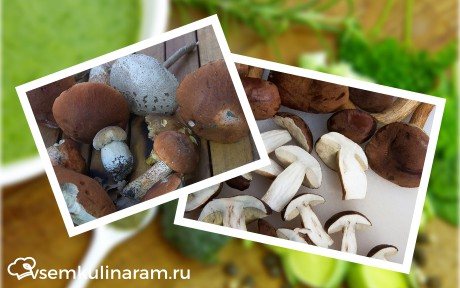

How to clean porcini mushrooms in the forest?
You need to peel the porcini mushroom, like all the collected mushrooms, in two passes.
- The first stage is preliminary cleaning directly at the collection point. This saves you enough time for the next cleaning.
- After the mushroom is picked and before sending it to the basket, shake off the coniferous branches, leaves and adhering dirt from the porcini mushroom.
- Any mushroom picker always has a knife with him. If worms have already encroached on the mushroom, then it is better to cut off even small parts that have been gnawed without sparing.
How to clean porcini mushrooms at home?
Basically, the porcini mushroom grows on dry, not too dirty surfaces. For this reason, the question often arises of how to peel a porcini mushroom and is it worth peeling at all? Worth cleaning. A dangerous bacterium can accumulate in the legs of the fungus, which causes diseases such as botulism. In addition, this bacterium does not die even after heat treatment.
Answers to common questions
Collecting boletus is a pleasure, because everyone understands its value and rejoices in the "catch". In order for cleaning to also delight you, it is important to study its secrets and do it with an understanding of the usefulness of all manipulations.
Cleaning of white mushrooms, and any other mushrooms collected in the forest, is a matter of incredible urgency, because over time, their fruit bodies lose moisture and taste. Ideally, it is better to carry out preliminary cleaning right in the forest, and upon arrival home, finally clear the crop of dust, earth and debris.
At first glance, cleaning is not particularly difficult, because you just need to scrape the leg and cap with a knife. But in fact, this process has several important nuances that will help not only preserve the freshness of the crop, but also its taste. In this article, we will look at basic information regarding cleaning boletus in the forest and at home before cooking.

